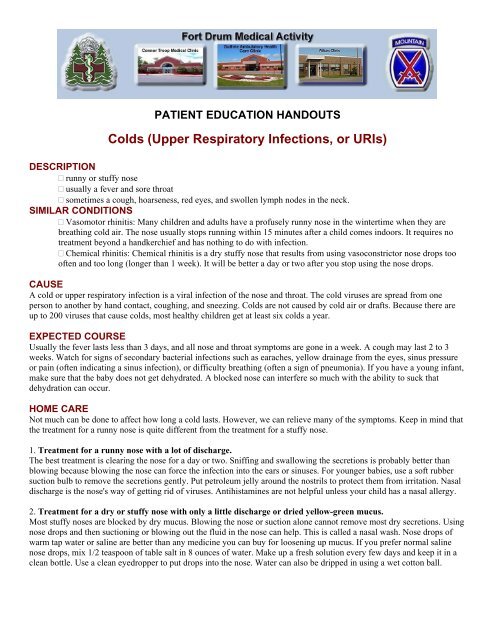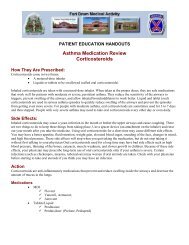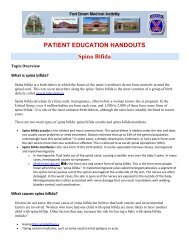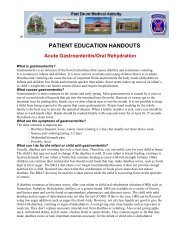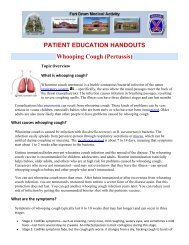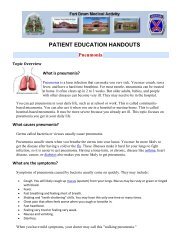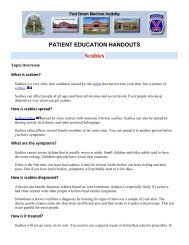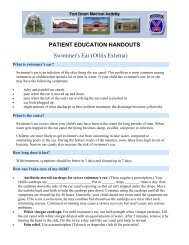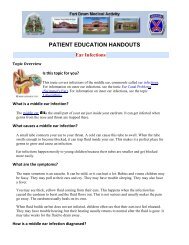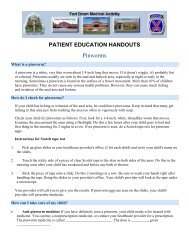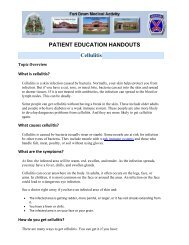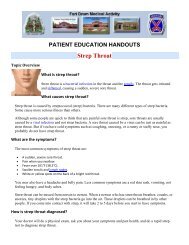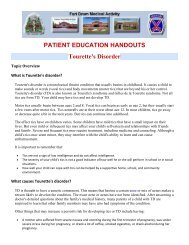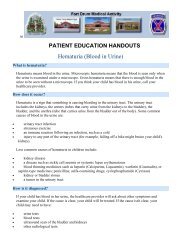Colds (Upper Respiratory Infections, or URIs)
Colds (Upper Respiratory Infections, or URIs)
Colds (Upper Respiratory Infections, or URIs)
Create successful ePaper yourself
Turn your PDF publications into a flip-book with our unique Google optimized e-Paper software.
PATIENT EDUCATION HANDOUTS<strong>Colds</strong> (<strong>Upper</strong> <strong>Respirat<strong>or</strong>y</strong> <strong>Infections</strong>, <strong>or</strong> <strong>URIs</strong>)DESCRIPTIONrunny <strong>or</strong> stuffy noseusually a fever and s<strong>or</strong>e throatsometimes a cough, hoarseness, red eyes, and swollen lymph nodes in the neck.SIMILAR CONDITIONSVasomot<strong>or</strong> rhinitis: Many children and adults have a profusely runny nose in the wintertime when they arebreathing cold air. The nose usually stops running within 15 minutes after a child comes indo<strong>or</strong>s. It requires notreatment beyond a handkerchief and has nothing to do with infection.Chemical rhinitis: Chemical rhinitis is a dry stuffy nose that results from using vasoconstrict<strong>or</strong> nose drops toooften and too long (longer than 1 week). It will be better a day <strong>or</strong> two after you stop using the nose drops.CAUSEA cold <strong>or</strong> upper respirat<strong>or</strong>y infection is a viral infection of the nose and throat. The cold viruses are spread from oneperson to another by hand contact, coughing, and sneezing. <strong>Colds</strong> are not caused by cold air <strong>or</strong> drafts. Because there areup to 200 viruses that cause colds, most healthy children get at least six colds a year.EXPECTED COURSEUsually the fever lasts less than 3 days, and all nose and throat symptoms are gone in a week. A cough may last 2 to 3weeks. Watch f<strong>or</strong> signs of secondary bacterial infections such as earaches, yellow drainage from the eyes, sinus pressure<strong>or</strong> pain (often indicating a sinus infection), <strong>or</strong> difficulty breathing (often a sign of pneumonia). If you have a young infant,make sure that the baby does not get dehydrated. A blocked nose can interfere so much with the ability to suck thatdehydration can occur.HOME CARENot much can be done to affect how long a cold lasts. However, we can relieve many of the symptoms. Keep in mind thatthe treatment f<strong>or</strong> a runny nose is quite different from the treatment f<strong>or</strong> a stuffy nose.1. Treatment f<strong>or</strong> a runny nose with a lot of discharge.The best treatment is clearing the nose f<strong>or</strong> a day <strong>or</strong> two. Sniffing and swallowing the secretions is probably better thanblowing because blowing the nose can f<strong>or</strong>ce the infection into the ears <strong>or</strong> sinuses. F<strong>or</strong> younger babies, use a soft rubbersuction bulb to remove the secretions gently. Put petroleum jelly around the nostrils to protect them from irritation. Nasaldischarge is the nose's way of getting rid of viruses. Antihistamines are not helpful unless your child has a nasal allergy.2. Treatment f<strong>or</strong> a dry <strong>or</strong> stuffy nose with only a little discharge <strong>or</strong> dried yellow-green mucus.Most stuffy noses are blocked by dry mucus. Blowing the nose <strong>or</strong> suction alone cannot remove most dry secretions. Usingnose drops and then suctioning <strong>or</strong> blowing out the fluid in the nose can help. This is called a nasal wash. Nose drops ofwarm tap water <strong>or</strong> saline are better than any medicine you can buy f<strong>or</strong> loosening up mucus. If you prefer n<strong>or</strong>mal salinenose drops, mix 1/2 teaspoon of table salt in 8 ounces of water. Make up a fresh solution every few days and keep it in aclean bottle. Use a clean eyedropper to put drops into the nose. Water can also be dripped in using a wet cotton ball.
F<strong>or</strong> the younger child who cannot blow his nose:Place three drops of warm water <strong>or</strong> saline in each nostril. After 1 minute use a soft rubber suction bulb tosuck out the loosened mucus gently. To remove secretions from the back of the nose, you will need toseal off both nasal openings completely with the tip of the suction bulb on one side and your fingerclosing the other side. If you cause a nosebleed, you are putting the tip of the suction bulb in too far. Youcan get a suction bulb at the drugst<strong>or</strong>e f<strong>or</strong> about $2. Try to buy a sh<strong>or</strong>t, stubby one with a clear-plasticmucus trap.F<strong>or</strong> the older child who can blow his nose:Use three drops in each nostril while your child is lying on his back on a bed with his head hanging overthe side. Wait 1 minute f<strong>or</strong> the water to soften and loosen the dried mucus. Then have your child blow hisnose. This can be repeated several times f<strong>or</strong> complete clearing of the nasal passages.Mistakes in using warm-water <strong>or</strong> saline nose drops:The main err<strong>or</strong>s are not putting enough water in the nose, not waiting long enough f<strong>or</strong> secretions to loosenup bef<strong>or</strong>e suctioning <strong>or</strong> blowing the nose, and not repeating the procedure until the breathing is easy. Thefront of the nose can look open while the back of the nose is all gummed up with dried mucus. Make surethat the nose is suctioned <strong>or</strong> blown after the warm-water nose drops are put in.Use the nasal wash at least 4 times a day <strong>or</strong> whenever your child can't breathe through the nose.3. The imp<strong>or</strong>tance of clearing the nose of a young infant.A child can't breathe through the mouth and suck on something at the same time. If your child is breast- feeding <strong>or</strong> bottlefeeding,you must clear his nose out so he can breathe while he's sucking. It is also imp<strong>or</strong>tant to clear your infant's nosebef<strong>or</strong>e you put him down to sleep.4. Treatment f<strong>or</strong> associated symptoms of colds.Fever: Use acetaminophen <strong>or</strong> ibuprofen f<strong>or</strong> aches <strong>or</strong> mild fever (over 102°F, <strong>or</strong> 38.9°C).S<strong>or</strong>e throat: Use hard candies f<strong>or</strong> children over 4 year’s old and warm chicken broth f<strong>or</strong> children over 1 yearold.Cough: Use cough drops f<strong>or</strong> children over 4 years old and 1/2 teaspoon c<strong>or</strong>n syrup f<strong>or</strong> younger children. Use ahumidifier to make the air in the room less dry.Red eyes: Rinse frequently with wet cotton balls.Po<strong>or</strong> appetite: Encourage drinking fluids by letting the child choose what to drink.5. Prevention of colds.A cold is caused by direct contact with someone who already has a cold. Over the years we are all exposed to many coldsand develop some immunity to them. Complications from colds are m<strong>or</strong>e common in children during the first year of life.Try to avoid undue exposure of young babies to other children <strong>or</strong> adults with colds, day care nurseries, and Churchnurseries. A humidifier prevents dry mucous membranes, which may be m<strong>or</strong>e susceptible to infections. Vitamin C,unf<strong>or</strong>tunately, has not been shown to prevent <strong>or</strong> sh<strong>or</strong>ten colds. Large doses of vitamin C (f<strong>or</strong> example, 2 grams) causediarrhea.6. Common mistakes in treating colds.Most over-the-counter cold remedies <strong>or</strong> tablets are w<strong>or</strong>thless. Nothing can make a cold last a sh<strong>or</strong>ter time. If the nose isreally running, consider using a pure antihistamine (f<strong>or</strong> example, chl<strong>or</strong>pheniramine products) if your child also hasallergies. Especially avoid drugs that have several ingredients because there is a greater chance of side effects from thesedrugs. Avoid <strong>or</strong>al decongestants if they make your child jittery <strong>or</strong> keep him from sleeping at night. Use acetaminophen f<strong>or</strong>a cold only if your child also has a fever, s<strong>or</strong>e throat, <strong>or</strong> muscle aches. Do not give leftover antibiotics f<strong>or</strong> uncomplicatedcolds because they have no effect on viruses and may be harmful.CALL YOUR CHILD'S PHYSICIAN IMMEDIATELY IF:Breathing becomes difficult AND no better after you clear the nose.Your child starts acting very sick.
CALL YOUR CHILD'S PHYSICIAN DURING OFFICE HOURS IF:The fever lasts m<strong>or</strong>e than 3 days.The runny nose lasts m<strong>or</strong>e than 10 days.The eyes develop a yellow discharge.You can't unblock the nose enough f<strong>or</strong> your infant to drink adequate fluids.You think your child may have an earache <strong>or</strong> sinus pain.Your child's throat becomes quite s<strong>or</strong>e (get a throat culture).You have other questions <strong>or</strong> concerns.Adapted from: Copyright © Clinical Reference Systems 1999Pediatric Advis<strong>or</strong> Jan 00Reviewed 24 July 2008


